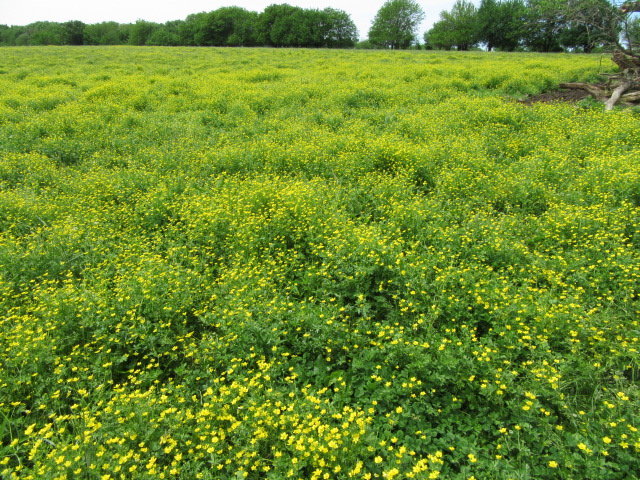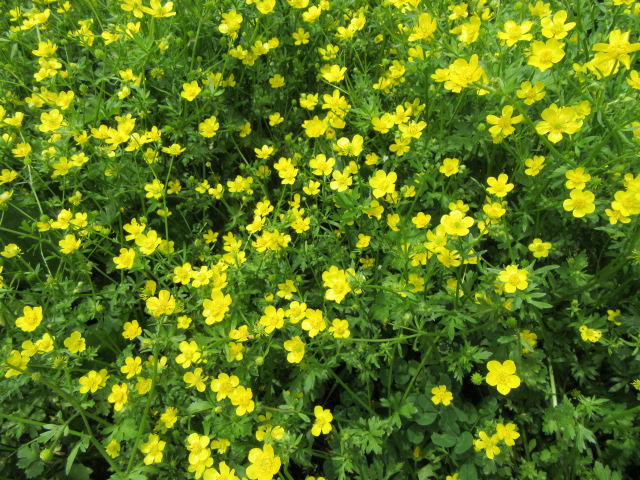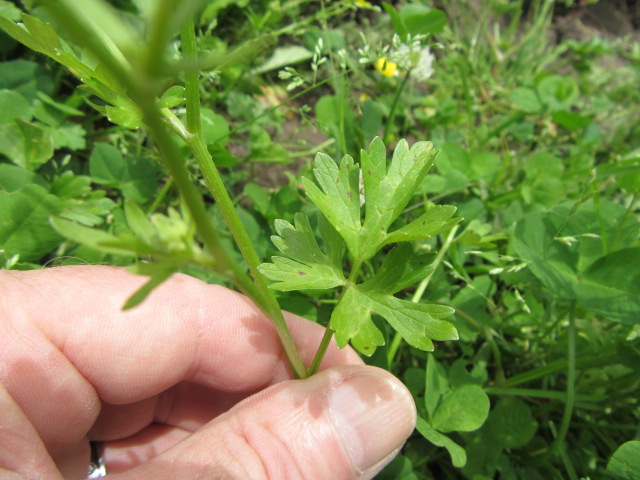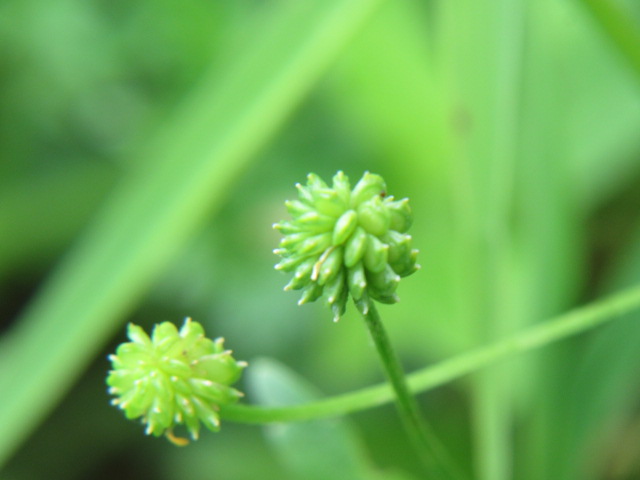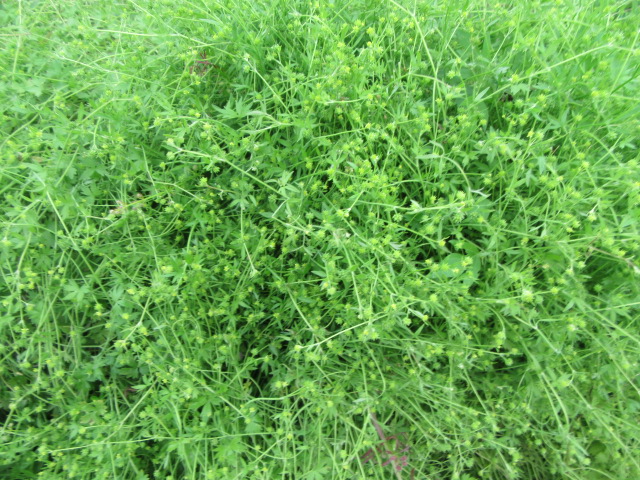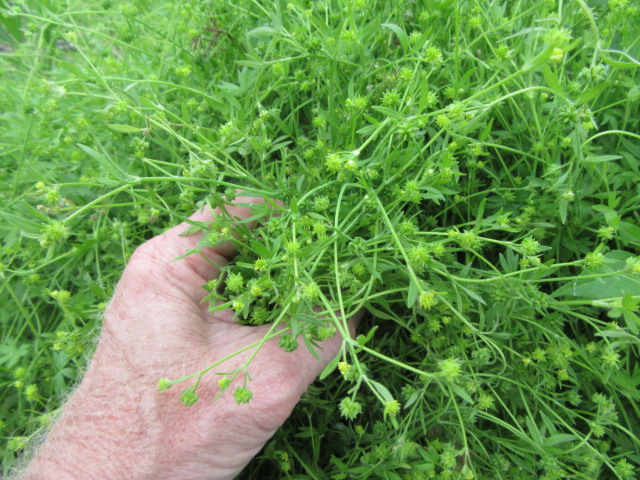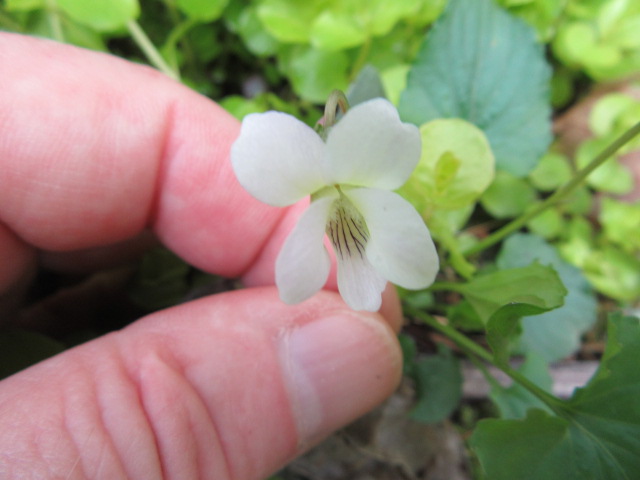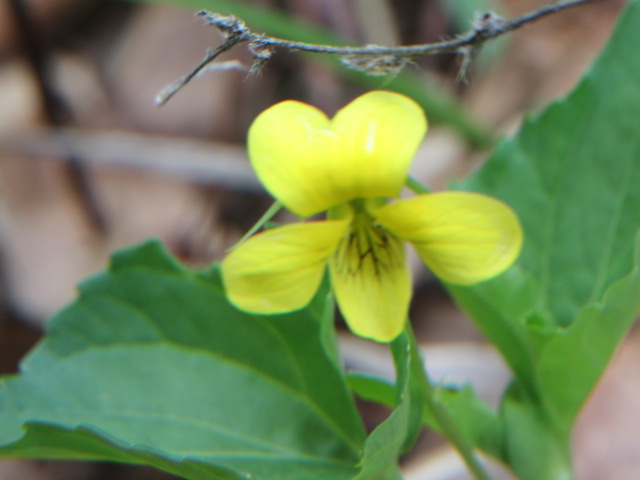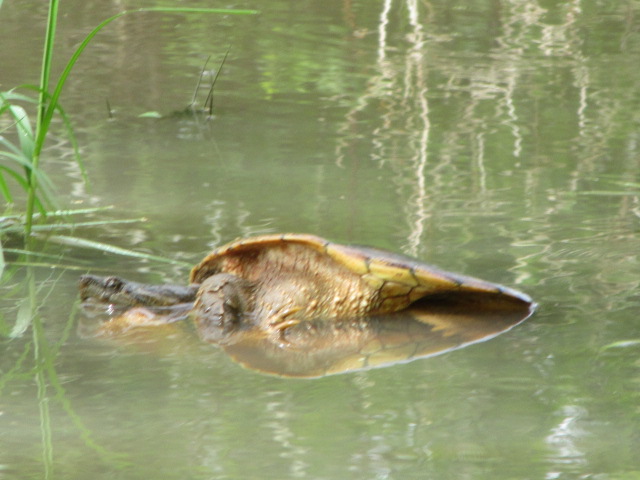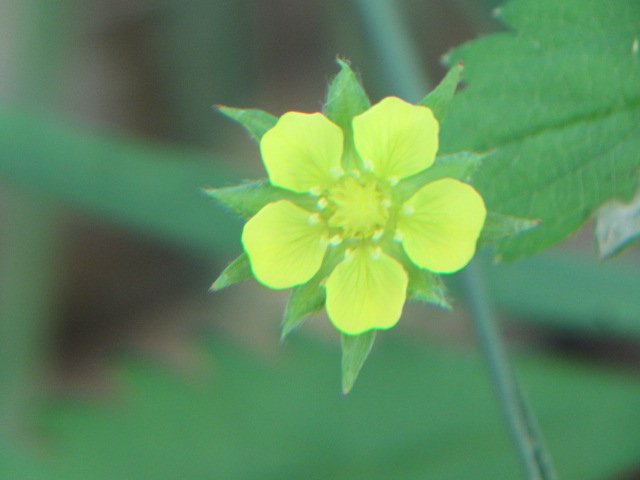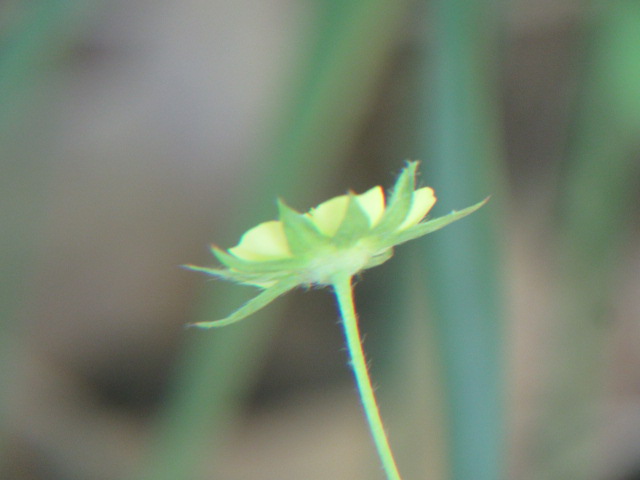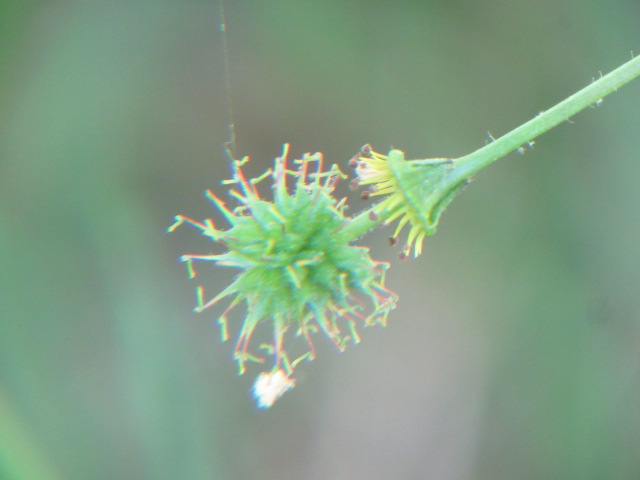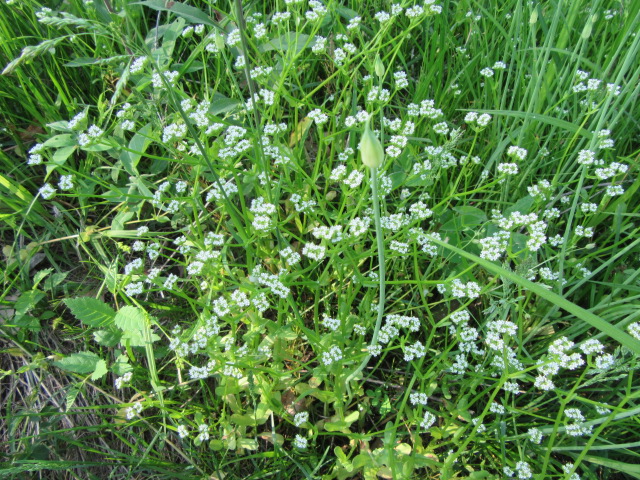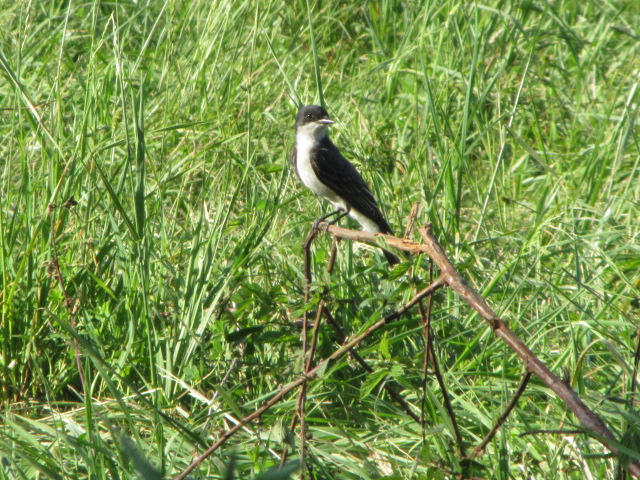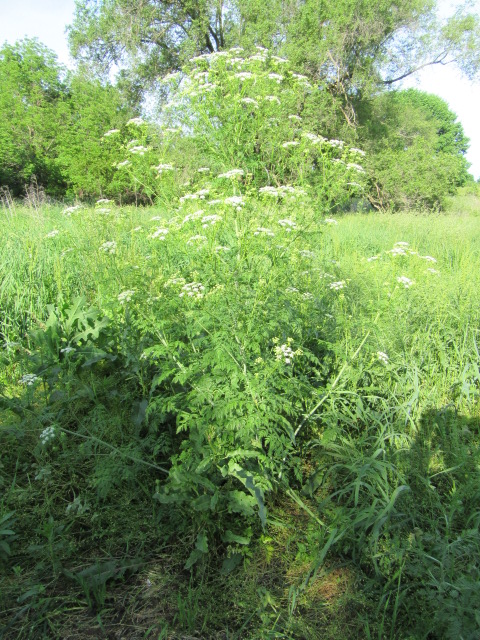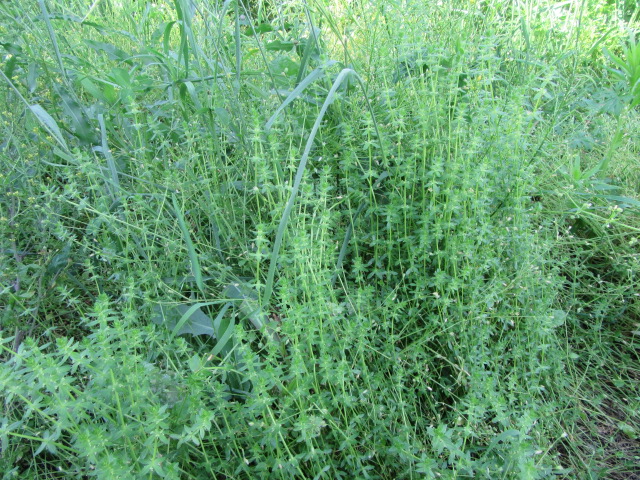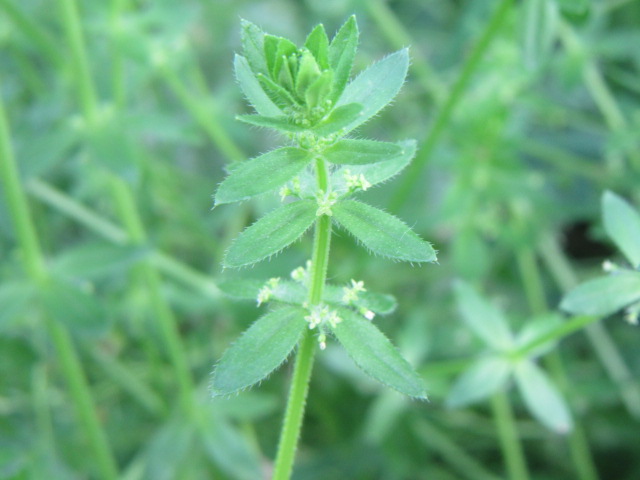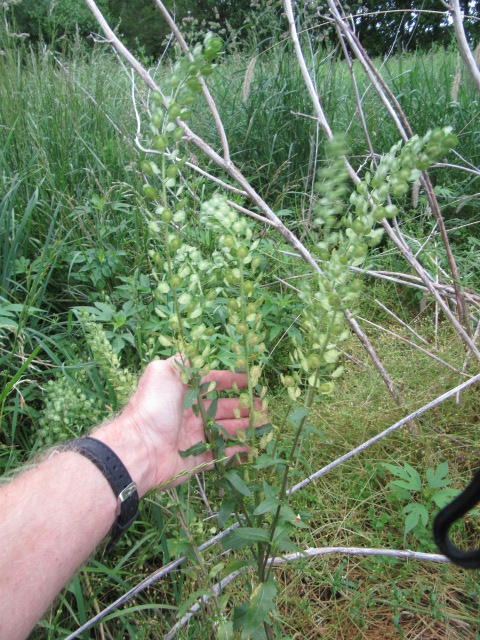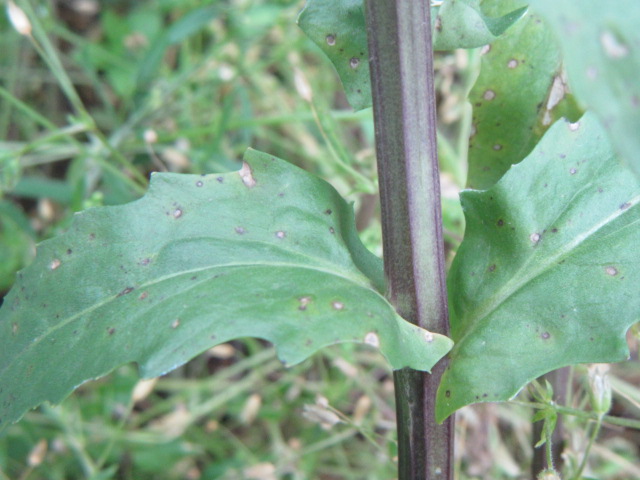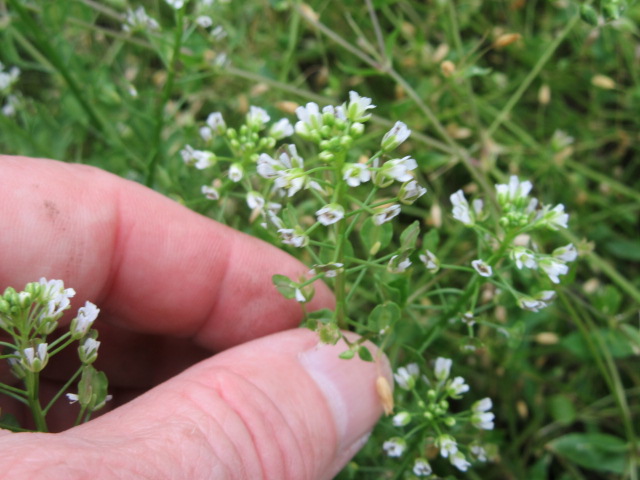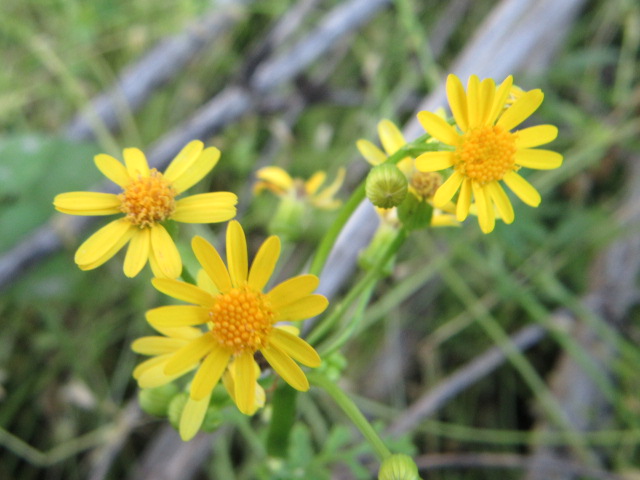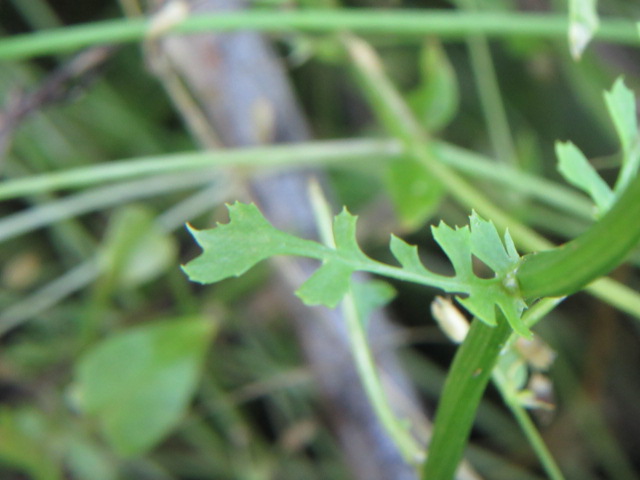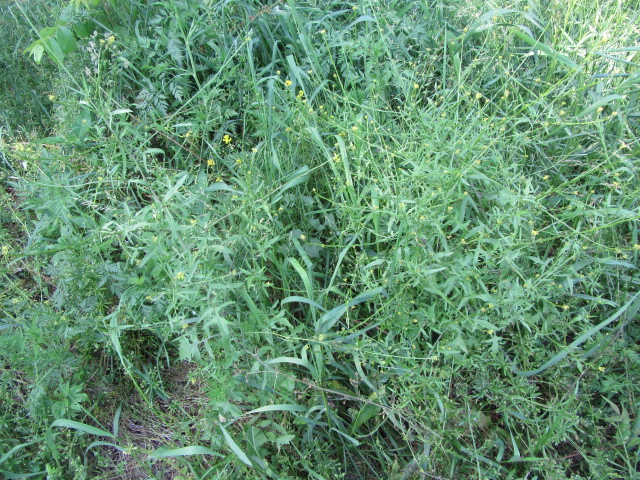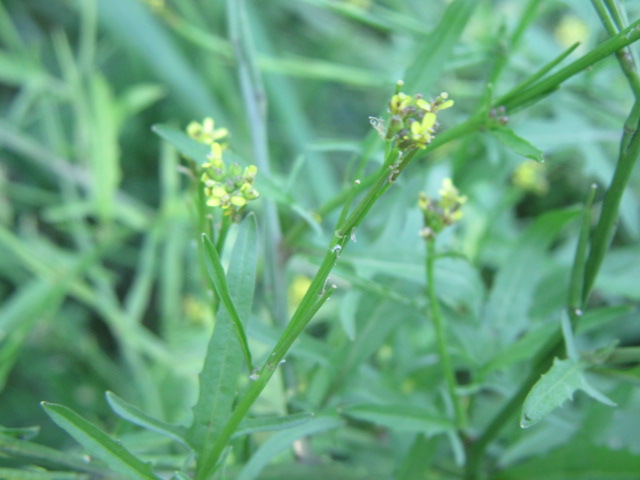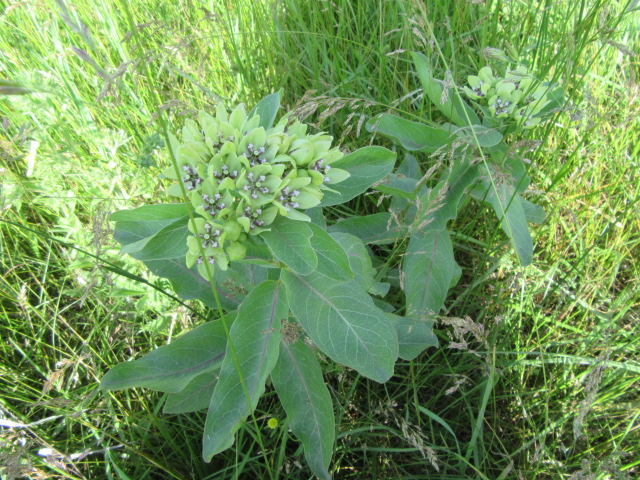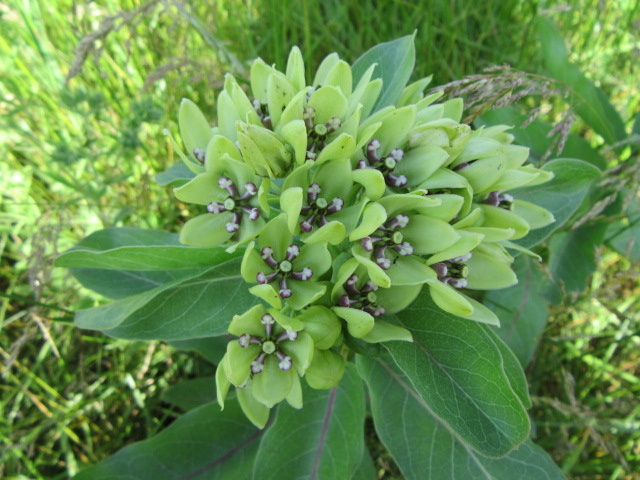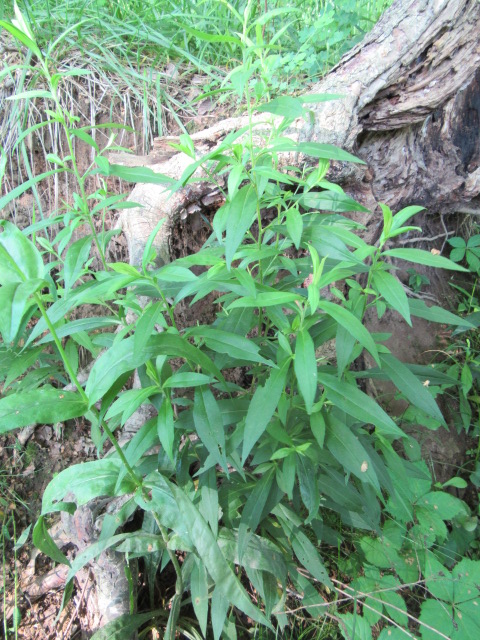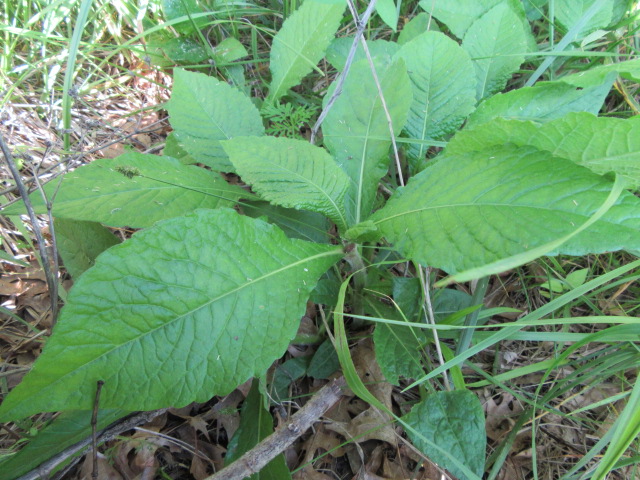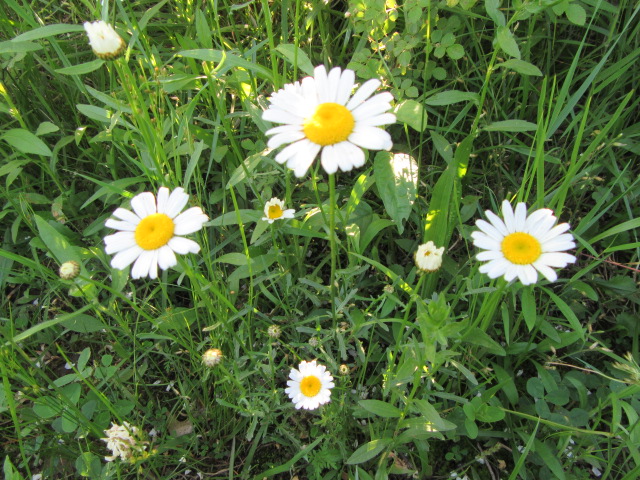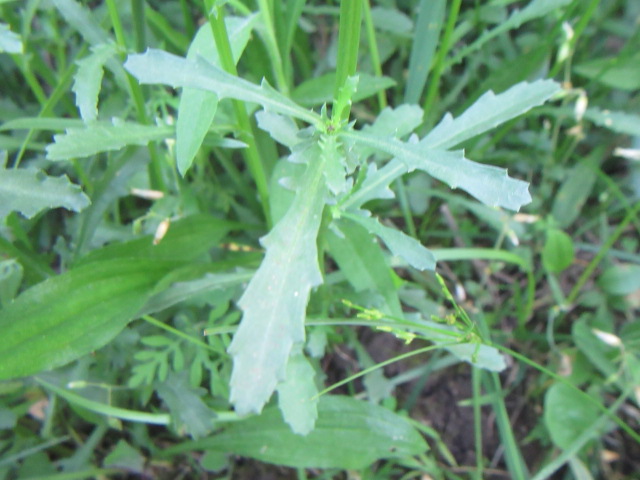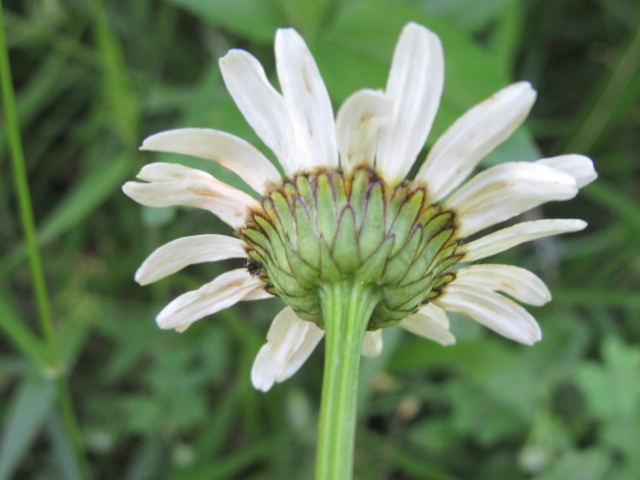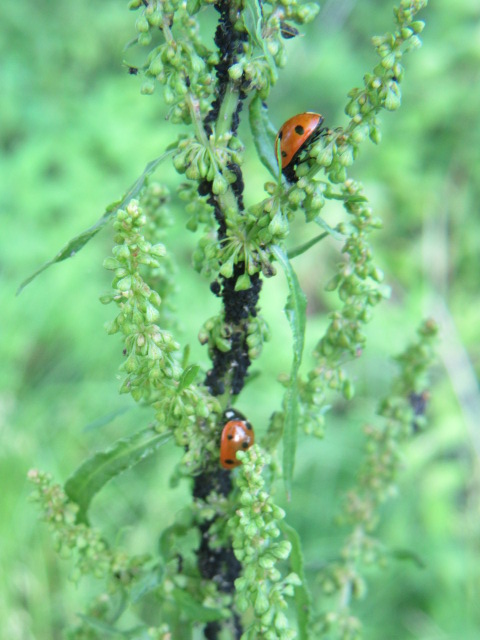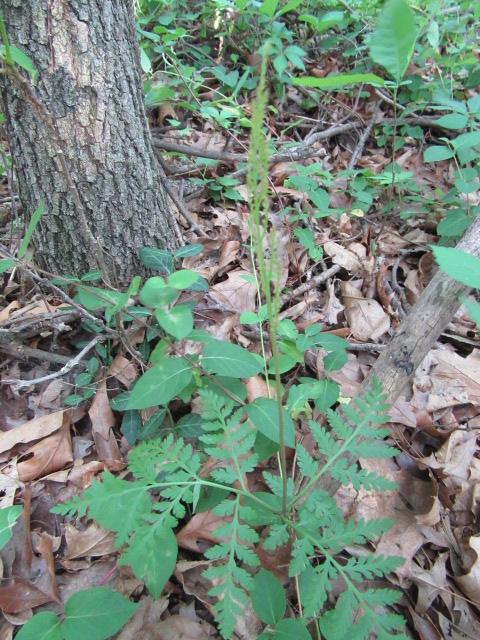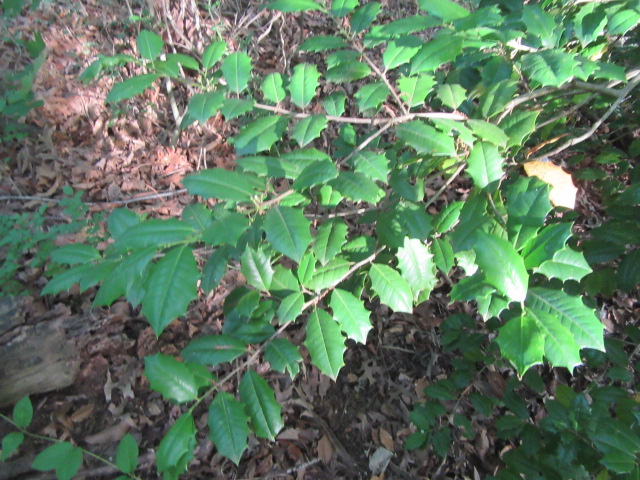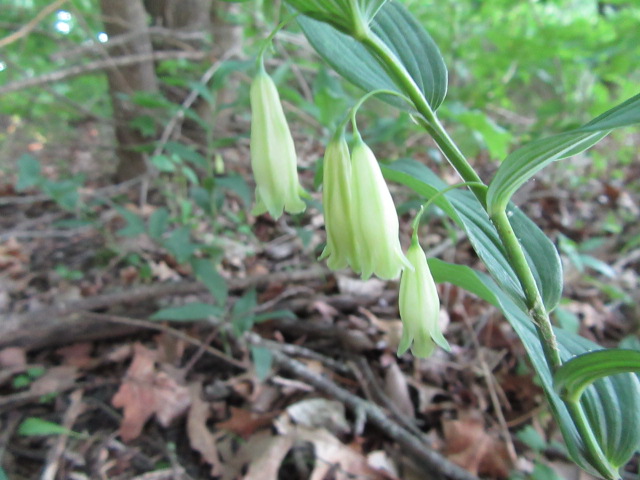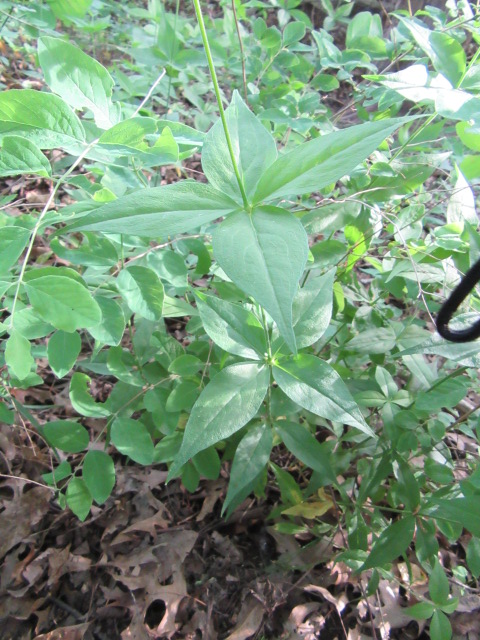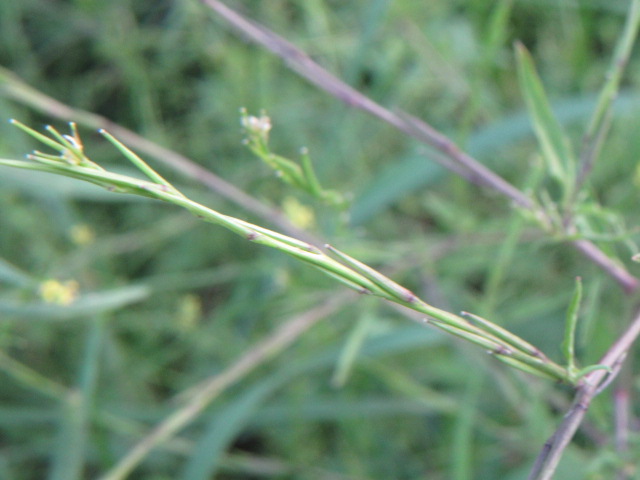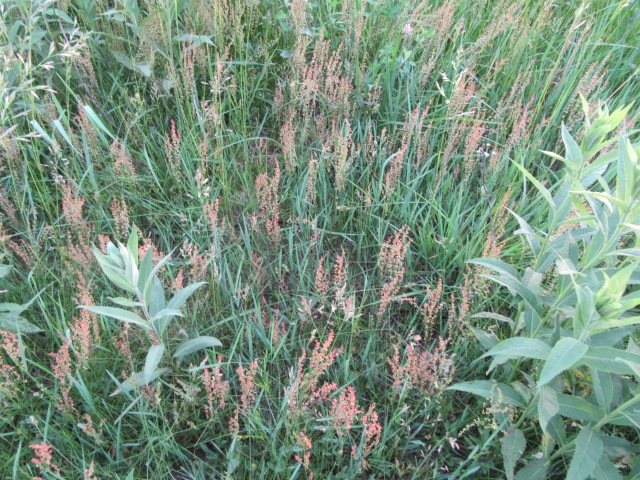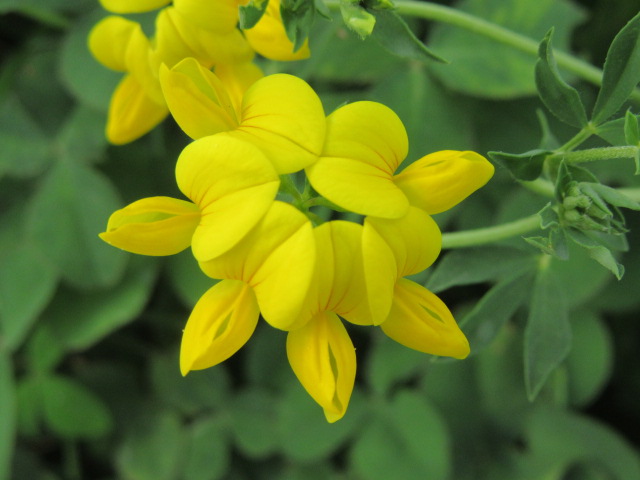
Lotus corniculatus (Bird’s Foot Trefoil) on Brandon Road along the south side of Farrington Park on 6-12-22, #890-36.
Hello everyone! I am back again with part two. It has been very hot but we had a little more rain which cooled things down a bit for a couple of days. It will be in the upper 90’s again this week. It’s OK as long as I can keep working in the shade and there is a little breeze.
Nothing exciting to report before I begin on the update for June… The hay has been cut which makes it easier to walk around in the hayfields although all the wildflowers there have also been cut down. There are still wildflowers in the wooded areas, along the fence rows, and around the pond to watch. Oh, yeah, and the trail.
So, let’s continue with June 5.
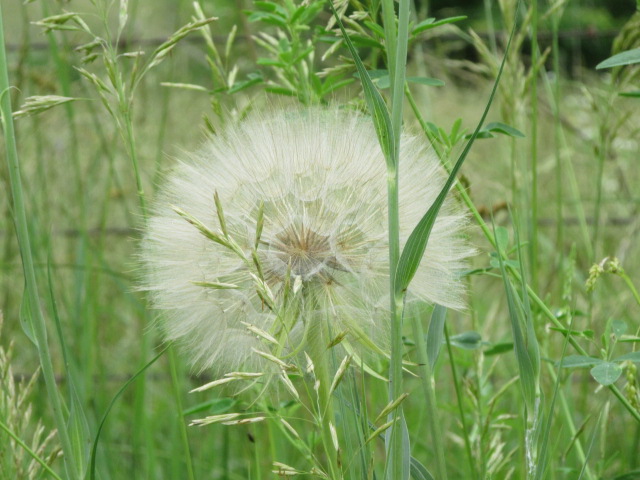
Tragopogon dubius (Yellow Salsify) on 6-5-22, #887-2.
There are two groups of these darn plants that keep evading getting photos of their flowers taken. They are growing in the jungle along the road in front of the southwest pasture/hayfield. I took photos of the plants and submitted them on iNaturalist for an ID and found out they are “likely” Tragopogon dubius (Yellow Salsify). Supposedly, the large yellow flowers are quite a sight and face the sun (like sunflowers). Unfortunately, on sunny days, the flowers usually close by noon. Even though I drive by them sometimes between 9-10 in the morning, I STILL haven’t managed to see them. They flower from April-August so maybe I still have a shot for a shot. The seed heads are around 5″ across and are a good 3′ in the air. This is the first year I have noticed them and I haven’t run across any on back roads or along the highways. It is also related to Tragopogon porrifolius which is used as an ornamental and their roots which taste similar to oysters. The USDA Plants Database lists 7 species and a few hybrids in North America… Tragopogon dubious (Yellow Salsify), T. porrifolius (Salsify), and T. pratensis (Jack-Go-To-Bed-At-Noon) are found throughout most of North America. All species are introduced species (not native), mainly from Europe and Africa, and have several common names…
JUNE 11…
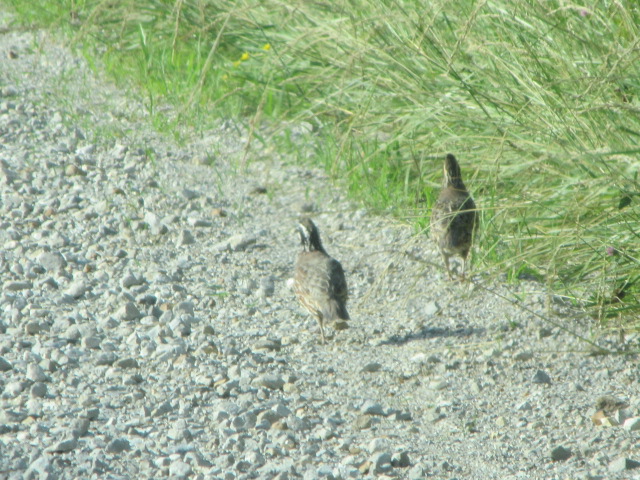
Colinus virginianus (Northern Bobwhite Quail), 6-11-22, #889-1.
You know, I have often wondered what happened to all the Bobwhite Quail. They were everywhere when I was a kid. When I moved to the farm in 1981 after grandpa died, there was always a pair that nested in the fence row around the yard and several elsewhere on the farm. When I moved back here in 2013, there were none. Dad said between the hawks and cats, they just disappeared. So, on my way back from a friend’s farm (Jay), a pair was walking down the road in front of me. I slowed down and they didn’t seem to be in any hurry. I stopped to take a few photos. I was very happy to see them and even happier I had my camera. 🙂
June 12…
On the way back home from Jay’s on the 11th, I took the road along the south side of the park. I noticed the Winecup Mallow was blooming up a storm. I had my camera so I’m not sure why I didn’t go ahead and take photos. Heck, it was almost a month ago. SO, I went back on the 12th… Ummm… I got a little carried away because I found A LOT of plants to photograph including a new species (new to me)…
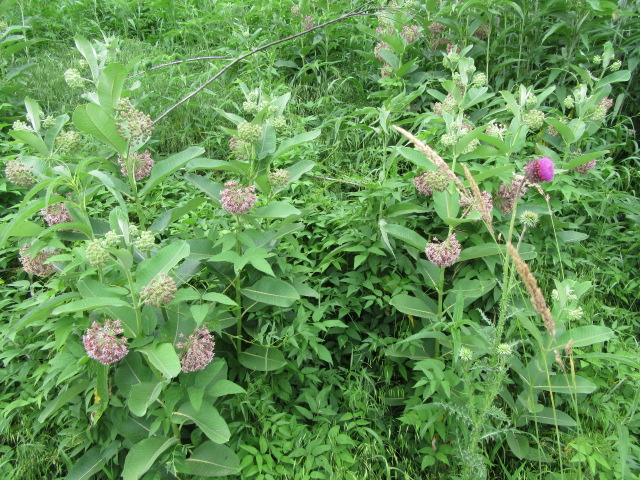
Asclepias syriaca (Common Milkweed) along the south side of the park on 6-12-22, #890-7.
I drove down Brandon Road which runs along the south side of the park. I passed what I went for and had to turn around in a driveway on the other side of the road just past the park. On the way back, I had to stop to take a few photos of a good-sized colony of Asclepias syriaca (Common Milkweed). There seems to be an abundance of these along the back roads and highways (at least the few I travel on).
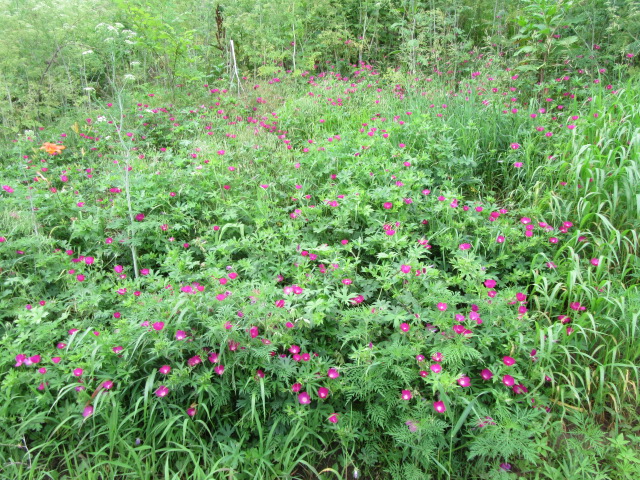
Callirhoe involucrata (Winecup Mallow) on 6-12-22, #890-11.
Then I drove back up to where the Callirhoe involucrata (Winecup Mallow) was. The colony seems to get bigger every year. It is a spectacular sight that brightens up the whole area.
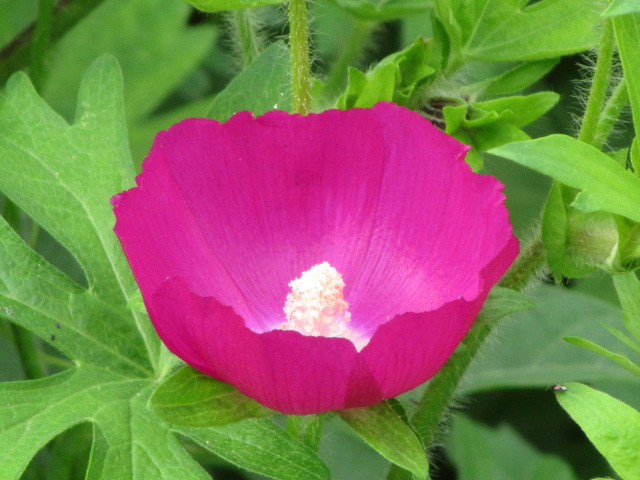
Callirhoe involucrata (Winecup Mallow) on 6-12-22, #890-18.
The flowers are so bright it can be difficult to get photos in bright light.
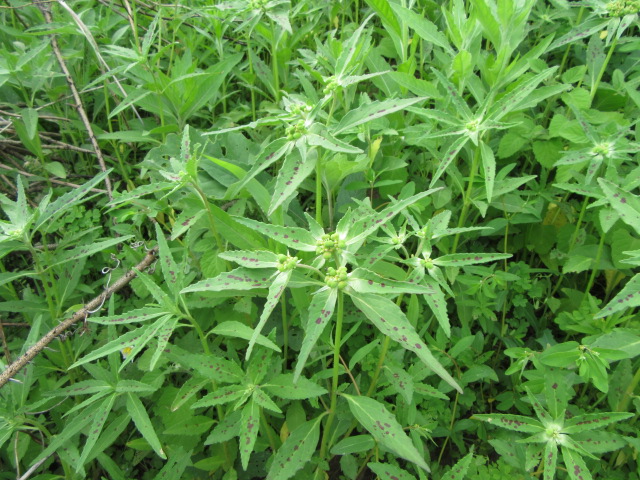
Euphorbia davidii (David’s Spurge) on 6-12-22, #890-24.
There were several other species of plants growing in and around the Winecup Mallow I had previously identified. But what caught my eye was one I hadn’t seen before but I knew what it was. Euphorbia davidii (David’s Spurge)…
I read about it before while working on the page for Euphorbia dentata (Green Poinsettia/Tooth Spurge) I found growing inside the old foundation last year. I “think” I found several plants growing along the front of the foundation this year, but they haven’t flowered yet… Ummm, they may have gotten trimmed off earlier… Well, I was looking inside the foundation for them. I did get some seeds from them but I neglected to plant them. GEEZ!
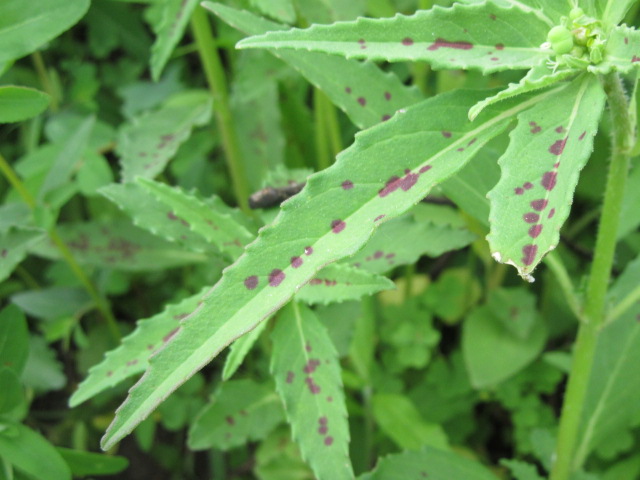
Euphorbia davidii (David’s Spurge) on 6-12-22, #890-27.
The Euphorbia davidii has longer, narrower leaves with maroon spots…
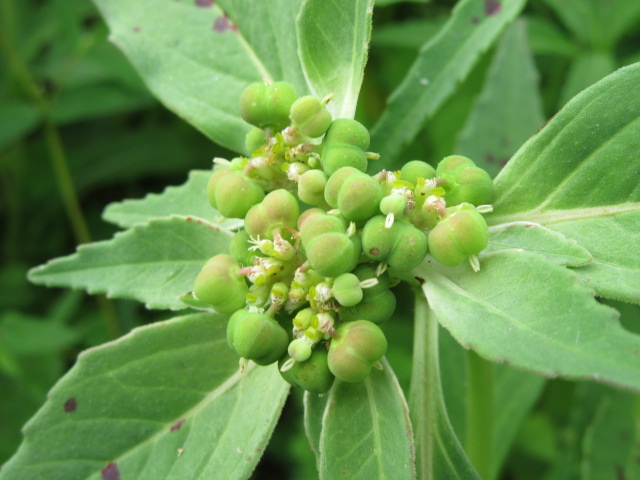
Euphorbia davidii (David’s Spurge) on 6-12-22, #890-30.
Like the Euphorbia dentata, it has these interesting fruits… As with other members of the family, they exude a milky latex sap that is not good for you.
Euphorbia davidii is native to mainly the southwest United States and Argentina, but has spread eastward and can also be found in southeast Canada.
After I was finished taking photos along the road next to the park, I went to the trail. I am still in search of the allusive Cutleaf Grapefern… It was about 6:15 PM.
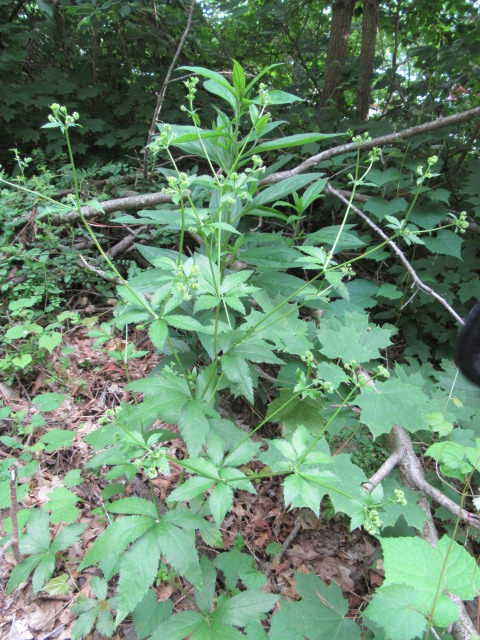
Sanicula canadensis (Black Snakeroot) on 6-12-22. #890-41.
One of the first plants I ran across was a nice Sanicula canadensis (Black Snakeroot). I first identified this species around the same area in 2021. This year I have found it in several areas on the farm. Despite its name, it is a neat plant that can grow around 4 1/2′ tall. It has odd flowers and neat leaves and has been used as a heart remedy…
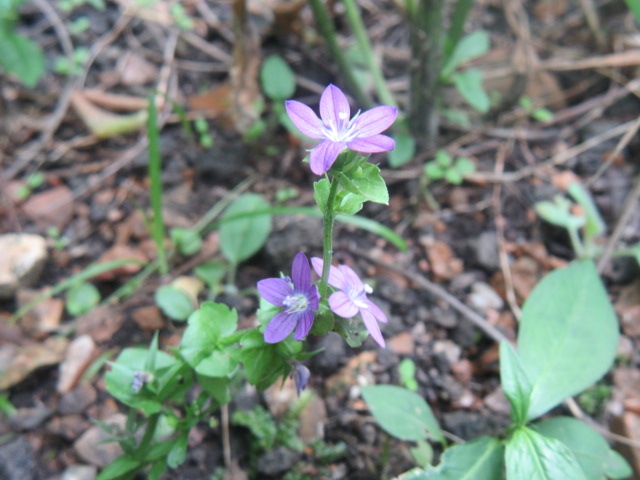
Triodanis perfoliata (Clasping Venus’s Looking Glass) on 6-12-22, #890-49.
I then ran across an old friend, the Triodanis perfoliata (Clasping Venus’s Looking Glass). What a neat little plant! I first identified this species from a single plant in the back of the farm in 2020, then found A LOT of them in the south hayfield in 2021.
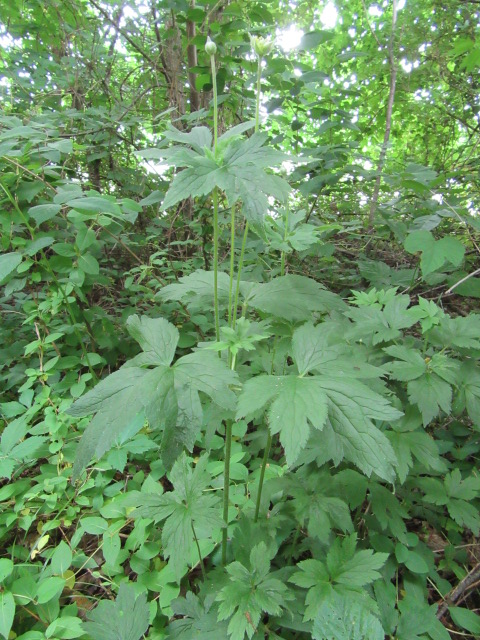
Anemone virginiana (Tall Thimbleweed) on 6-12-22, #890-1).
Then I ran across the stately Anemone virginiana (Tall Thimbleweed). I first identified this species along the trail a year ago and there aren’t that many. These plants can also grow to around 4′ tall and have neat, good-sized leaves. They grow from a single stem and branch out at the top.
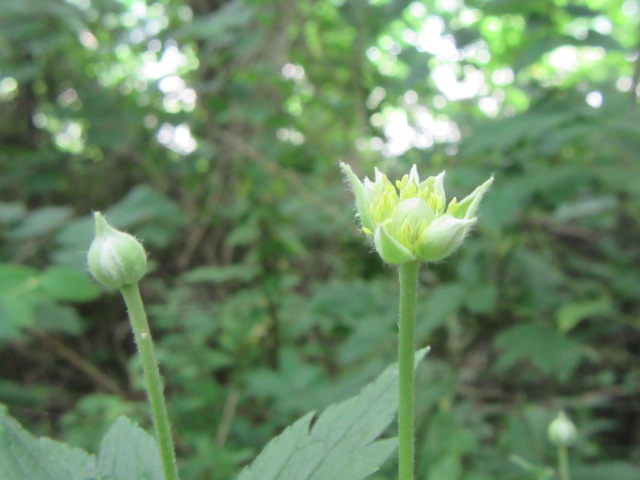
Anemone virginiana (Tall Thimbleweed) on 6-12-22, #890-5.
The flowers emerge at the top of long petioles, while the involucral bracts are 5-15″ below the flowers…
I was finally able to get into the trees in several spots… I looked here and there and there was no sign of the fern…
THEN FINALLY!!!

Sceptridium dissectum (Cutleaf Grapefern) on 6-12-22, #890-46.
There it was!!! The Sceptidium dissectum (Cutleaf Grapefern). I found several in April here and there but they seemed to have disappeared and the one I did find was small and weird… Well, at least I managed to find this one!
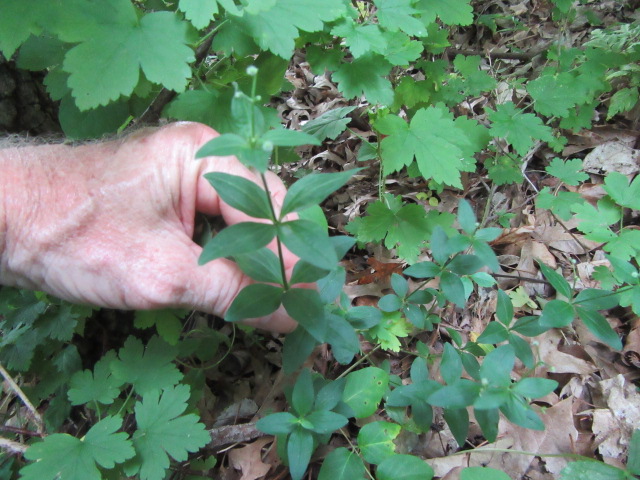
Galium circaezans (Forest or Licorice Bedstraw) on 6-12-22, #890-31.
I continued looking to see if I could find more of the Grapefern. I walked into this one spot and turned around and saw this plant that resembled Silene stellata (Starry Campion) but something was a bit off… Silene Stellata isn’t supposed to have flowers like that! I took several photos to upload on iNaturalist and found out it was yet another Galium species called Galium circaezans, commonly known as Forest or Licorice Bedstraw.
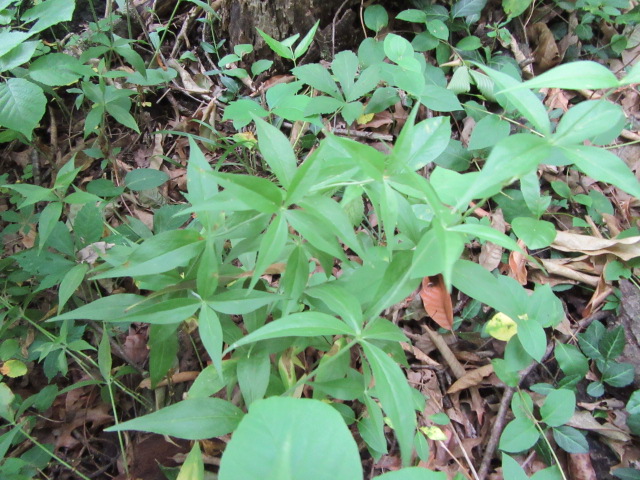
Silene stellata (Starry Campion) on 6-12-22, #890-47.
There are A LOT of Silene stellata (Starry Campion) along the trail but finding them in flower is a different story! Missouri Plants say they bloom from June to September, so I thought I could keep an eye on them since they are right next door! Well, I went back to the trail on July 17 and all I found were dried-up flowers. GEEZ!!!
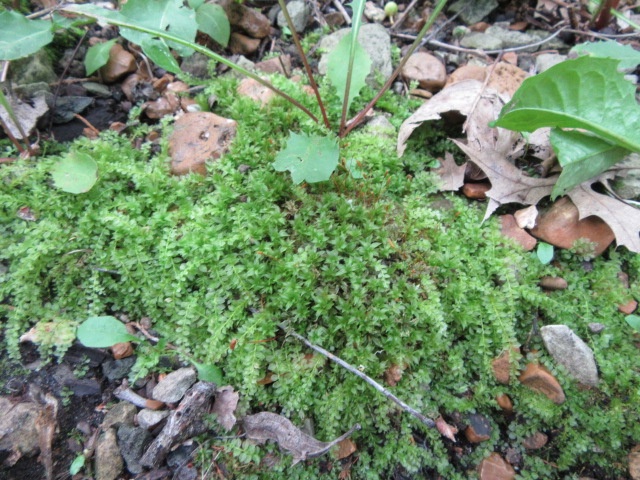
Plagiomnium cuspidatum (Woodsy Thyme-Moss) on 6-12-22, #890-37.
I found several clumps of Plagiomnium cuspidatum (Woodsy Thyme-Moss) which are always neat with their long fern-like leaves.
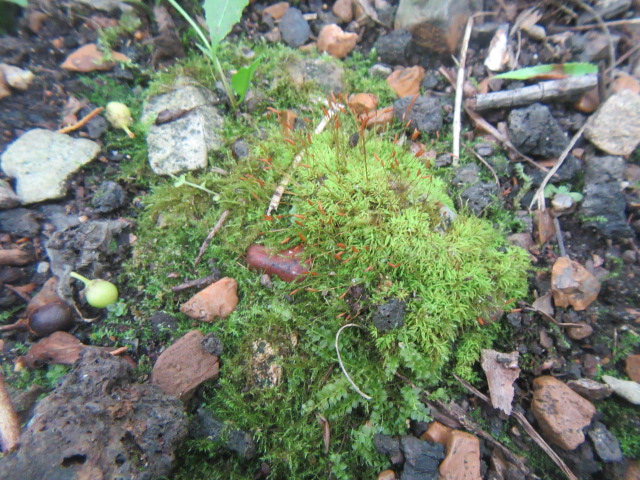
Entodon seductrix (Seductive Entodon Moss) on 6-12-22, #890-22.
Then, I ran across a new moss called Entodon seductrix (Seductive Entodon Moss). Hmmm…
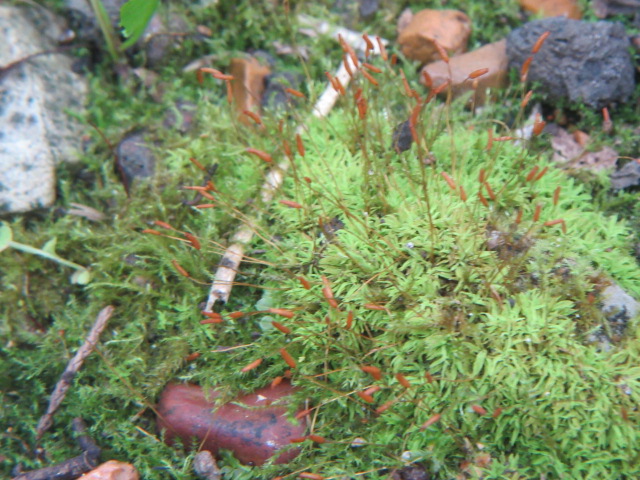
Entodon seductrix (Seductive Entodon Moss) on 6-12-22, #890-23.
Mosses are interesting and some species look A LOT alike. I did get some close-ups but they weren’t good enough to save. They did prove the species name, however, with a little imagination and help with iNaturalist and a few other websites.
JUNE 14…

Erigeron divaricatus (Dwarf Conyza or Dwarf Fleabane) on 6-14-22, #891-2.
I decided it was high time I identified these weird fuzzy-looking plants that like growing in the cracks in the driveway. They turned out to be Erigeron divaricatus commonly called Dwarf Conyza or Dwarf Fleabane. Hmmm… It’s an Erigeron species? Related to Erigeron canadensis (Syn. Conyza canadensis) (Horsetail) and Erigeron annuus (Annual Fleabane) Weird! You would never imagine they are related…
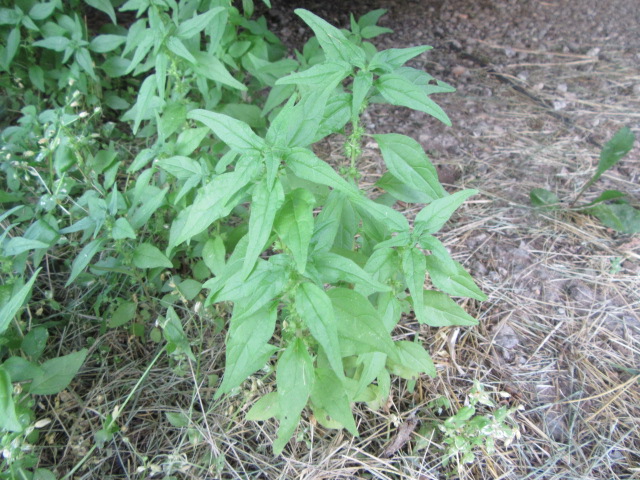
Parietaria pensylvanica (Pennsylvania Pellitory) on 6-14-22, #891-8.
Then this other plant said, “WHAT ABOUT ME? I have been here forever and you always pass me by”. So, I said, “OK, OK. I’ll take your photo.” It turned out to be Parietaria pensylvanica (Pennsylvania Pellitory). Considered a common weed found in almost every state in the United States, in Canada, and even down into Mexico.
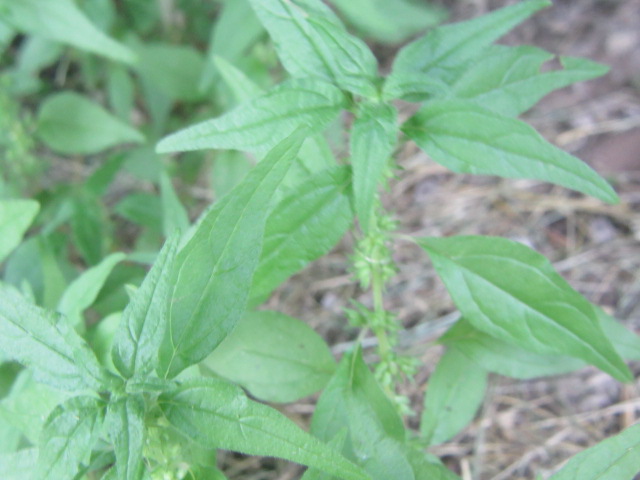
Parietaria pensylvanica (Pennsylvania Pellitory) on 6-14-22, #891-9.
Their flowers have no petals and appear along the stems at leaf nodes. This species is a non-stinging member of the nettle family Urticaceae… The genus name means “walls” and the common name “Pellitory” also refers to it growing along walls… Hmmm…
JUNE 16…

Galium circaezans (Forest or Licorice Bedstraw) on 6-16-22, #892-6.
Then when I was working on Kevin’s landscaping on June 16, I found another Galium circaezans (Forest or Licorice Bedstraw)! It was growing through the ivy in front of a blue spruce! You just never know what you will find or where when you least expect it…
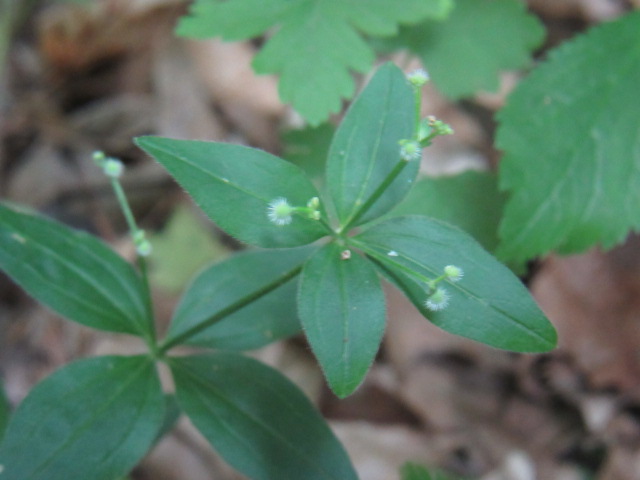
Galium circaezans (Forest or Licorice Bedstraw) on 6-12-22, #890-34.
Some day I will get better photos of the flowers…
JUNE 22…
When I was driving along the back roads on June 22, I noticed a few clumps of these yellow flowers I hadn’t noticed before. Some of the colonies kind of had a raggy appearance and wasn’t sure if I could get good photos…
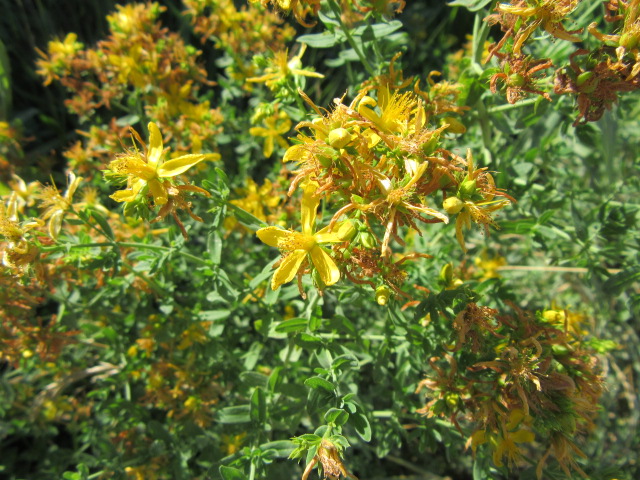
Hypericum perforatum (Common St. John’s Wort) on 6-22-22, #894-3.
Then, along a curve, I found a patch that looked a little better. I didn’t recognize the species, so I took A LOT of photos. The wind was blowing and the sun was fairly bright in this location, so I knew some of the photos wouldn’t be that great. When I got home, I uploaded the photos on iNaturalist. The first suggestion was Hypericum perforatum also known as the Common St. John’s Wort. Hmmm…
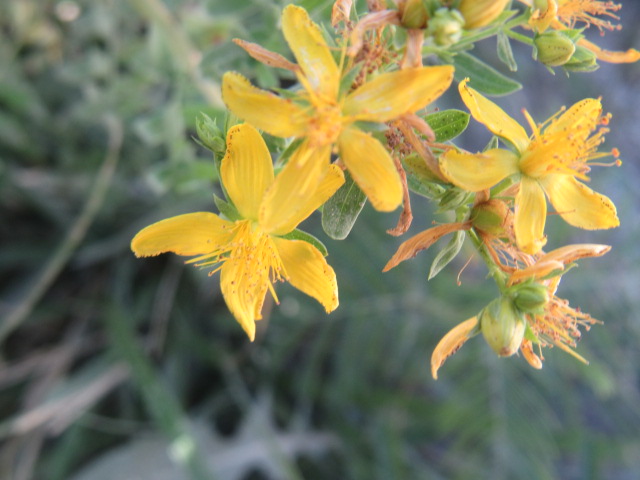
Hypericum perforatum (Common St. John’s Wort) on 6-22-22, #894-7.
It’s a good thing I was able to get a good close-up or I would have had to go back and take more photos. Even so, you can’t hardly see the spots along the margins of the petals. You may have to use your imagination…
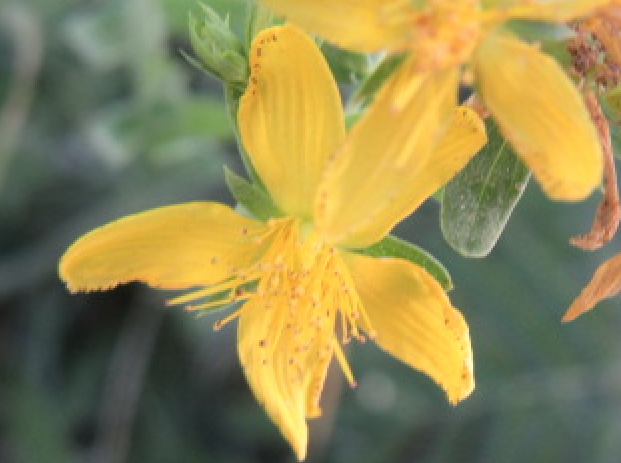
OK, here’s a zoomed-in screenshot…
In 2019, I found a few Hypericum punctatum (Spotted St. John’s Wort) in the southeast corner of the farm. The petals and buds were covered with spots. I have searched for it every year since but never saw the little “wort” again…
JUNE 24…
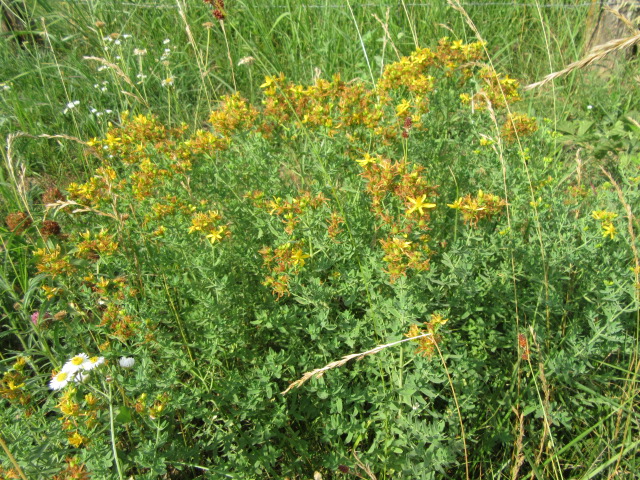
Hypericum perforatum (Common St. John’s Wort) on 6-24-22, #895-2.
After a couple of days, I went back to the same curve and got a shot of the colony of the Hypericum perforatum…
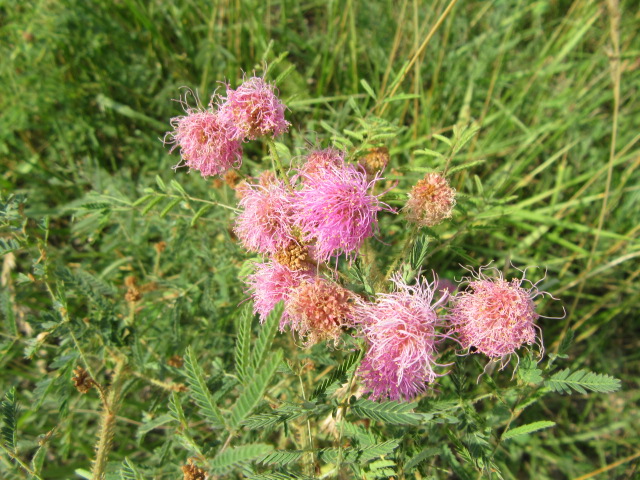
Mimosa nuttallii (Catclaw Briar) on 6-24-22, #894-3.
Right in the same area, I noticed these weird fluffy pink flowers. I went over to examine them and realized it was a plant I had been wondering about for several years. I actually never saw them in bloom, but I could tell from their leaves. When I uploaded the photos on iNaturalist, it confirmed Mimosa nuttallii whose common names are Catclaw Briar, Sensitive Briar (or Brier), and probably others. If you get stuck by their thorns you would likely call them something else…
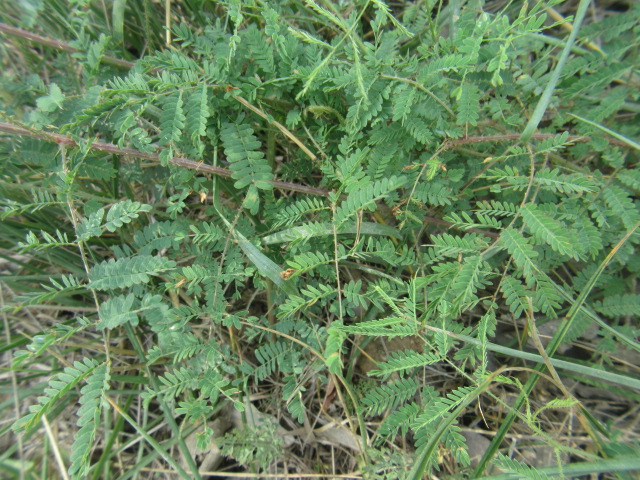
Mimosa nuttallii (Catclaw Briar) on 6-24-22, #894-5.
The small leaves resemble those from mimosa or locust trees, or a few other plants with similar ferny leaves… I remember as a kid I would find them and tough their leaves to see what happens. I am now 61 and I still do it!
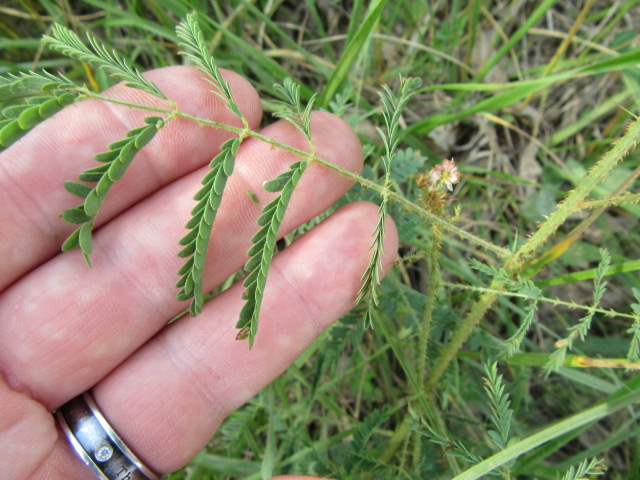
Mimosa nuttallii (Catclaw Briar) on 6-24-22, #894-7.
It was kind of an exciting nostalgic moment when I touched the leaves and they closed up!
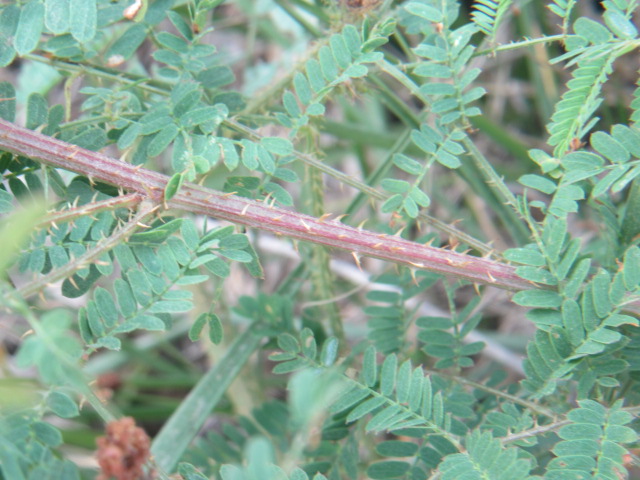
Mimosa nuttallii (Catclaw Briar) on 6-24-22, #894-6.
One thing I don’t remember as a kid is the thorns. YIKES! I guess they protect the sensitive leaves…
It is weird how many species of plants are on this same corner. I have stopped there several times in the past to take photos.
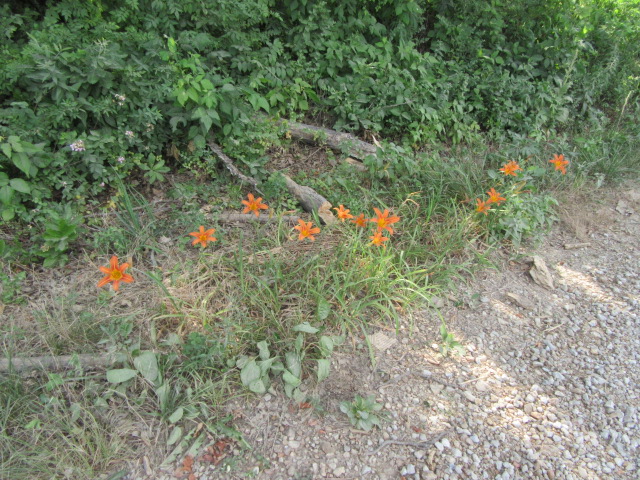
Hemerocallis fulva (Orange Day-Lily), 6-24-22, #895-1.
Across the road was a small colony of Hemerocallis fulva (Orange Day-Lily). This has been a great year for them because I have seen them growing here and there on just about every road I have been on (some very large colonies). They are native to several Asian countries but now grow wild in other countries and a good part of the United States. According to the Wikipedia article, they were planted and naturalized in Europe as early as the 16th century. They are listed as wildflowers on several websites, including Missouri Plants. As you know, there are HUNDREDS of cultivars these days, but the plants on my farm (planted by my grandparents) and on many old homesteads have the same old orange flowers. Common names include Orange Day-Lily, Tawny Daylily, Corn Lily, Tiger Daylily, Fulvous Daylily, Ditch Lily, Fourth of July Lily, Railroad Daylily, Roadside Daylily, Outhouse Lily, Wash-House Lily, and probably others…
I think I will close this post and get ready for part 3… It will be about the photos I took on June 26. There are too many to include in this post.
Until then… Be safe, stay positive, keep cool, always be thankful, and GET DIRTY if you get a chance!
